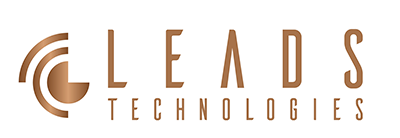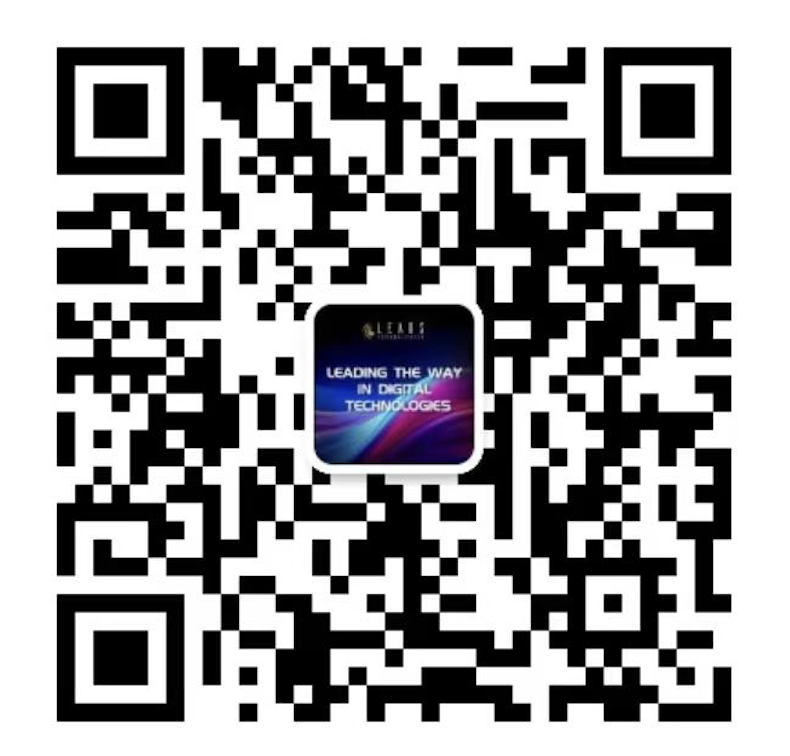- Introduction: Why Do Businesses Need Personalization Tools in 2025?
- Five Key Considerations Before Choosing a Tool
- How Do Analyst Firms Evaluate These Tools?
- Overview of 8 Popular Personalization Marketing Tools and Use Cases
- Feature Comparison Table
- Recommendations by Industry and Business Size
- Implementation Suggestions: Start Small and Scale Gradually
- Conclusion: Choose the Right Tools to Make Personalization Work
- References
- Introduction: Why Do Businesses Need Personalization Tools in 2025?
- Five Key Considerations Before Choosing a Tool
- How Do Analyst Firms Evaluate These Tools?
- Overview of 8 Popular Personalization Marketing Tools and Use Cases
- Feature Comparison Table
- Recommendations by Industry and Business Size
- Implementation Suggestions: Start Small and Scale Gradually
- Conclusion: Choose the Right Tools to Make Personalization Work
- References
1. Introduction: Why Do Businesses Need Personalization Tools in 2025?
As digital competition intensifies, businesses must leverage more precise personalized marketing to improve customer loyalty and conversion rates. According to market trends, personalization will become one of the key competitive advantages in enterprise digital marketing in 2025.
However, with numerous personalization tools available — such as Adobe Target, Salesforce Marketing Cloud, and Adobe Journey Optimizer — how should businesses choose the most suitable solution for their needs? This article provides an in-depth introduction to the 8 most popular personalization marketing tools in 2025, along with detailed feature comparisons and selection recommendations, helping enterprises quickly grasp the essentials and make the best decisions.
2. Five Key Considerations Before Choosing a Tool
There are hundreds of personalization marketing tools on the market, and their features often sound very similar. Prices can range from tens of thousands to millions of dollars. So how exactly should a business choose? Before diving into specific comparisons, understanding the following five key evaluation criteria will help you effectively filter out the most suitable solutions for your unique situation.
Whether It Can Integrate with Existing Systems and Data Sources
Businesses rarely start from scratch — they usually already have a CRM, membership system, web analytics tool, or other marketing platforms in place. The personalization tool you choose, whether it can integrate with existing data and platforms (such as Adobe, Salesforce, GA, LINE, etc.), will directly impact the feasibility and cost of implementation.
Whether to support cross-channel interaction (Web, App, Email, LINE, etc.)
Modern customer journeys often span multiple channels. A good personalization tool should enable consistent personalized experiences across platforms, allowing you to deliver aligned messages across websites, apps, EDMs, push notifications, and even LINE, avoiding fragmented experiences where "one channel says one thing, and another says something different."
Whether the team is easy to get started
Some tools may be powerful, but if they are complex to operate and have a steep learning curve, they can actually slow down marketing efforts. It's important to evaluate whether the tool offers user-friendly features such as a visual interface, pre-built modules, and journey orchestration tools, and also consider whether your technical team can support the underlying integration and setup.
Whether it has advanced functions such as AI and automation
If you want to do more than just 'manual recommendations' and hope to adjust content, recommend products, and trigger messages in real-time based on customer behavior, then it is crucial that the tool supports AI recommendations, behavior prediction, and automated journey orchestration. This will determine how far and how deeply you can go with your personalization efforts.
Cost, maintenance and scalability assessments
Beyond the initial implementation cost, it's also important to consider ongoing operational expenses, license scalability, API connection fees, and other hidden costs. Some tools are better suited for SMEs looking to launch quickly, while others are more appropriate for large enterprises focused on long-term strategies. It is recommended to evaluate the "total cost of ownership over three years" when making a decision, which provides a more accurate picture than focusing solely on the upfront licensing fee.
3. How Do Analyst Firms Evaluate These Tools?
When selecting a personalization marketing tool, in addition to reviewing feature lists and pricing, referencing professional analysis from third-party analyst firms is a quick and effective approach. These organizations provide objective insights into each tool’s positioning and performance through market research, user feedback, and technical evaluations — helping enterprises avoid unnecessary detours.
Below are three of the most representative international analyst reports, along with how the eight tools we recommend perform in these reports:
3.1 Gartner Magic Quadrant for Personalization Engines (November 2024)
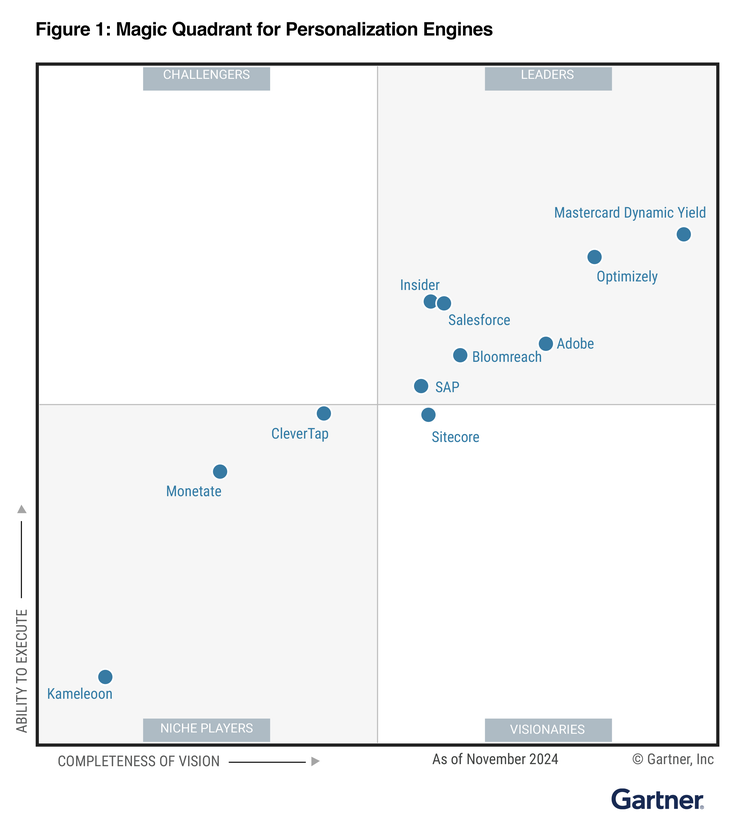
Gartner’s evaluation of personalization engines assesses vendors across two dimensions: “Ability to Execute” and “Completeness of Vision.” Vendors are categorized into four quadrants: Leaders, Challengers, Visionaries, and Niche Players.
In the latest 2024 edition:
- Leaders Quadrant:
- Dynamic Yield (Mastercard): Leads in both execution capability and strategic vision, making it the top choice for e-commerce and retail brands.
- Optimizely, Adobe, Salesforce, Insider: All demonstrate consistent performance and broad deployment cases, suitable for large enterprises.
- Bloomreach is also recognized as a Leader due to its strong integration of content and recommendation capabilities.
- Visionaries Quadrant:
- SAP and Sitecore: Possess clear strategies but still have room for improvement in execution. Best suited for companies already within their ecosystem.
This report clearly shows that if your business requires high performance, flexible integration, and AI-driven personalization capabilities, Adobe, Dynamic Yield, Salesforce, Insider, and Bloomreach are currently leading brands in the market.
3.2 Forrester Wave™: Digital Experience Platforms (Q3 2021)
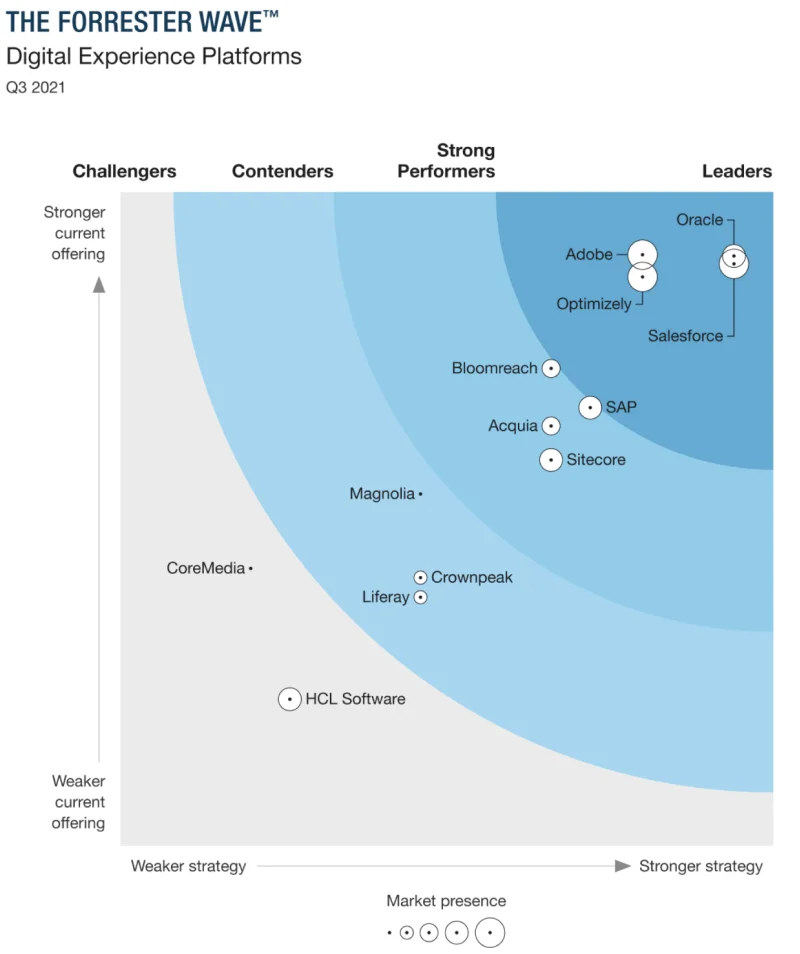
The Forrester Wave report places greater emphasis on long-term strategy planning and platform completeness, particularly analyzing enterprise-grade Digital Experience Platforms (DXP). This makes it especially valuable when evaluating integrated solutions combining “content management + personalization.”
In this report:
- Leaders Category:
- Salesforce, Adobe, Oracle: Demonstrated strong capabilities in integrating content management, data processing, and personalized experiences.
- Optimizely also entered the Leaders category thanks to its flexible website optimization and content experience tools.
- Strong Performers Category:
- Bloomreach, SAP, Sitecore: Though not yet fully in the Leaders category, they offer comprehensive features and scalable strategies, gaining favor among specific industries.
This report highlights that if your business cares not only about marketing conversion but also about “overall customer experience management and content workflow integration,” the completeness and future-readiness of these tools make them highly trustworthy.
3.3 Summary: Why We Selected These 8 Tools
Based on the intersection of insights from these two authoritative reports, the following eight tools stand out in terms of execution capability, market adoption, product innovation, and content integration:
- Adobe Target
- Adobe Journey Optimizer
- Salesforce Marketing Cloud Personalization
- Dynamic Yield
- Insider
- Bloomreach
- Emarsys (SAP)
- Optimizely
These tools are not only recognized by analyst firms as either “Leaders” or “Strong Performers,” but also widely adopted by enterprises across various industries.
4. Overview of 8 Popular Personalization Marketing Tools and Use Cases
Choosing the right tool is one of the key factors in successfully implementing a personalization marketing strategy. Based on the previous chapter’s analysis and real-world applications, we’ve compiled a list of eight solutions known for their maturity, flexibility, and scalability. The following section introduces each tool and its applicable use cases to help businesses quickly understand their positioning and strengths.
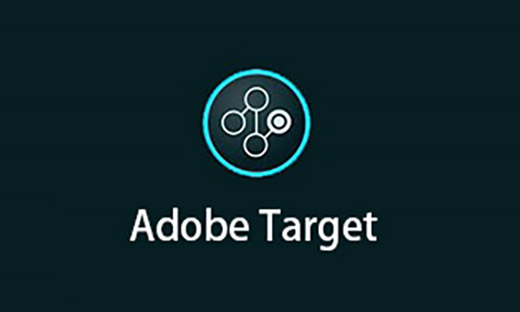
Adobe Target
Product Positioning:
Adobe Target is an enterprise-grade personalization and experimentation platform, specifically designed for brands that want to conduct A/B testing, multivariate experiments, and AI-driven content recommendations. As one of the core components of Adobe Experience Cloud, it seamlessly integrates with Adobe Analytics and Adobe Audience Manager, enabling a truly data-driven marketing ecosystem.
Main Features:
· A/B testing and multivariate testing (MVT)
· Auto-Target and Auto-Allocate features that use AI to automatically optimize content display
· Page content block personalization and recommendation modules
· Deep integration with other Adobe products, allowing connection to CDP, web behavior data, CRM, and more
Target Users and Use Cases:
· Mid-to-large enterprises already using Adobe Experience Cloud
· Marketing and digital transformation teams aiming to improve website conversion rates and optimize user experiences
· Common applications include homepage layout testing, product recommendation modules, and behavior-based content adjustments
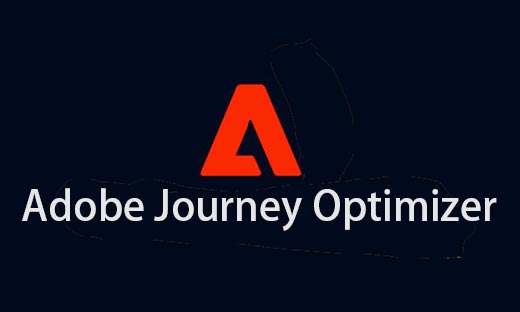
Adobe Journey Optimizer
Product Positioning:
Adobe Journey Optimizer is a real-time marketing automation tool built on the Adobe Experience Platform (AEP), enabling brands to design cross-channel personalized customer journeys based on behavior and attributes. With a focus on real-time data, a unified customer view, and journey orchestration, it is ideal for enterprises seeking multi-channel integration.
Main Features:
· Real-time triggered messaging (e.g., Email, App push, SMS, LINE)
· Drag-and-drop journey design interface with support for branching logic and conditional controls
· Integration with Adobe Real-Time CDP for unified customer data and behavior tracking
· Support for contextual personalization: automatically switch content based on customer behavior
Target Users and Use Cases:
· Enterprises that have already adopted the Adobe Experience Platform
· Marketing teams looking to integrate Web, App, CRM, and push interactions
· Common applications include new member onboarding, cart abandonment recovery, and birthday-triggered notifications
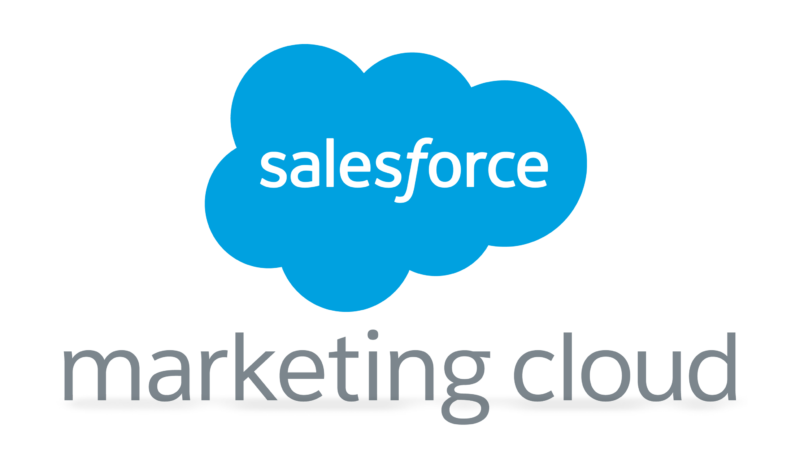
Salesforce Marketing Cloud Personalization (formerly Interaction Studio)
Product Positioning:
Salesforce Marketing Cloud Personalization is a real-time engagement and personalization module within the Salesforce ecosystem. It seamlessly integrates with Salesforce CRM, Sales Cloud, and Service Cloud, helping enterprises deliver consistent and personalized content experiences throughout the customer journey.
Main Features:
· Real-time behavior tracking and web content personalization
· Dynamic content adjustment for email, websites, and apps based on audience attributes
· Strong predictive modeling and audience segmentation capabilities
· Integration with Salesforce Einstein AI to improve recommendation accuracy
Target Users and Use Cases:
· Mid-to-large enterprises in finance, education, insurance, and other industries using the Salesforce ecosystem
· Brands requiring cross-departmental (sales, service, marketing) integration of customer interaction data
· Common applications include website block personalization, segmented content recommendations, and automated sales follow-ups
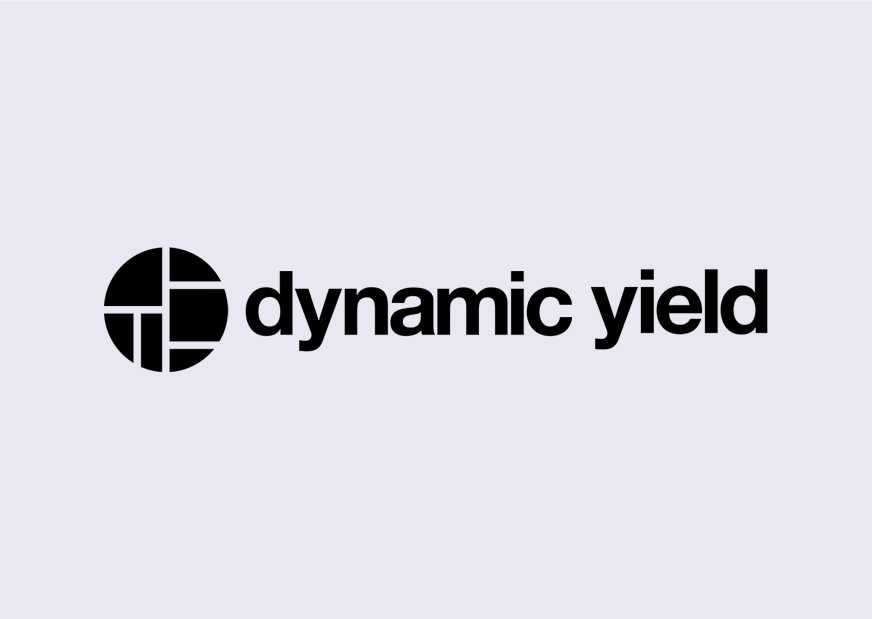
Dynamic Yield
Product Positioning:
Dynamic Yield (now part of Mastercard) is a highly modular personalization platform, known for its fast deployment and flexible configuration. It is especially suitable for brands that require flexible marketing control across multiple scenarios, including e-commerce recommendations, UX optimization, A/B testing, and interactive push engagement.
Main Features:
· Product recommendation engine with drag-and-drop setup and customizable recommendation logic
· Highly flexible page popups, overlay modules, and CTA design options
· Visual management of customer journeys and content templates
· Built-in AI models and machine learning support
Target Users and Use Cases:
· E-commerce/retail brands and enterprises with in-house UX teams
· Digital teams looking to quickly launch and fully control all user interaction content
· Common applications include recommendation modules, promotional popups, and segmented registration flow optimization
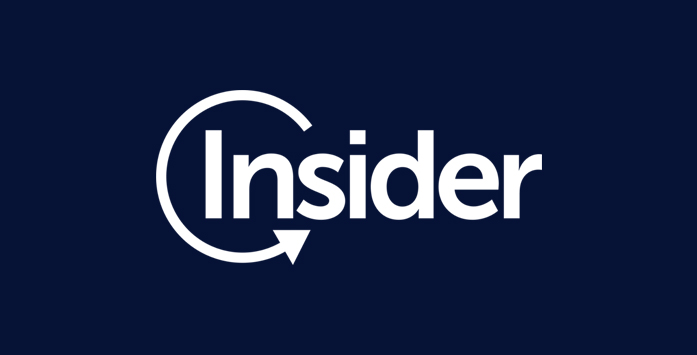
Insider
Product Positioning:
Insider is a rapidly growing growth marketing platform in the Asia-Pacific market. It emphasizes ease of use and "omnichannel engagement" capabilities, with built-in powerful AI-driven segmentation and journey orchestration modules — making it popular among B2C brands and local marketing teams.
Main Features:
· Supports multi-channel messaging across Web, App, Email, LINE, WhatsApp, and more
· Visual journey builder with intuitive segmentation rule setup
· AI-powered product recommendations, browsing behavior prediction, and user lifecycle analysis
· Strong local language and market support with fast deployment
Target Users and Use Cases:
· B2C brands looking for quick implementation and visual operation interfaces
· Businesses focused on App/website channels and customer lifecycle management
· Common applications include cart abandonment reminders, member push notifications, and churn warning message design
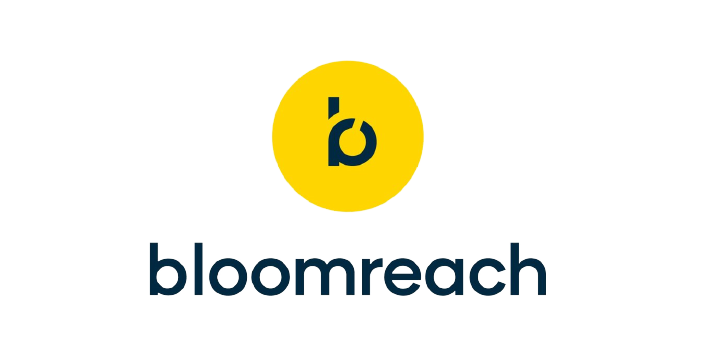
Bloomreach
Product Positioning:
Bloomreach is an integrated platform specialized in optimizing e-commerce experiences, combining AI-powered search, content management (CMS), and personalization recommendation capabilities. It is especially suitable for mid-to-large e-commerce platforms with extensive product catalogs and complex categorization.
Main Features:
· Optimized product search with intelligent ranking
· Accurate recommendation modules that automatically adapt to visitor behavior
· Deep integration between CMS and recommendation engine
· Support for cross-recommendations of content and products (Content x Commerce)
Target Users and Use Cases:
· E-commerce platforms and brand websites managing complex product data
· Marketing and product teams looking to manage both content and recommendation logic
· Common applications include personalized search results, optimized category page rankings, and content block recommendations
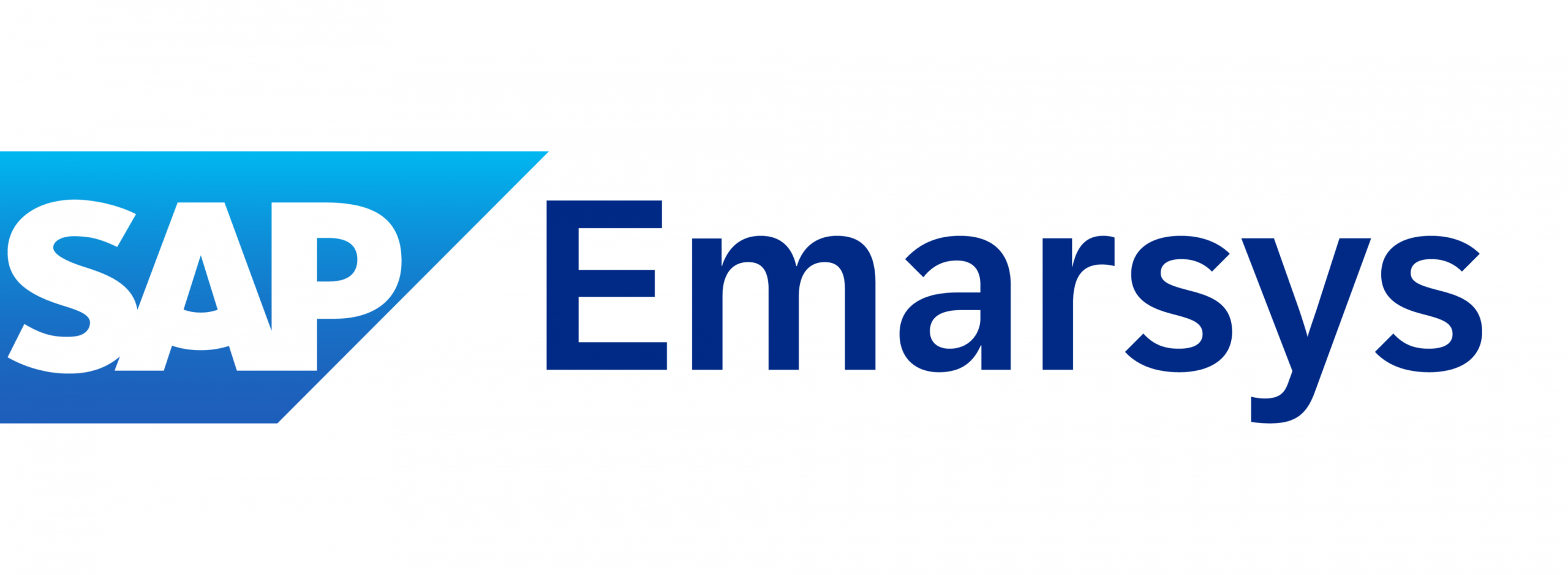
Emarsys (SAP)
Product Positioning:
Emarsys is a cloud-based marketing platform under SAP, focused on email marketing automation and cross-channel personalized engagement. It comes with a variety of pre-built journey templates, enabling brands to deploy and scale quickly.
Main Features:
· Email marketing automation with integrated push notifications and SMS
· Predefined marketing journey scenarios (e.g., birthdays, order notifications, repurchase reminders)
· Seamless integration with SAP Commerce and SAP CDP
· Supports real-time behavioral segmentation and optimal send-time recommendations
Target Users and Use Cases:
· Brands within the SAP ecosystem or marketing teams primarily focused on email campaigns
· Enterprises looking for quick implementation with strong support for predefined scenarios
· Common applications include customer re-engagement campaigns, automated order notifications, and personalized email messaging

Optimizely
Product Positioning:
Optimizely (formerly Episerver) is a comprehensive digital experience platform that evolved from web A/B testing. In recent years, it has strengthened its content management and recommendation engine capabilities, becoming an integrated and highly scalable personalization solution.
Main Features:
· A/B testing, behavioral experiment management, and multi-version page control
· Integration of CMS and commerce systems, enabling synchronized optimization of content and transactional flows
· Highly flexible recommendation modules and audience segmentation logic
· Capable of integration with third-party systems via APIs
Target Users and Use Cases:
· Content-driven or functional websites (B2B, education, insurance, etc.)
· Enterprise teams requiring frequent experimentation, version testing, and UX optimization
· Common applications include marketing page layout testing, download process optimization, and recommendation module testing
5. Feature Comparison Table of Personalization Tools
The market offers a wide variety of personalization marketing tools, each with its own positioning and feature set. To help enterprise readers quickly grasp the key differentiators, we’ve compiled the following comparison table, analyzing tools across five dimensions:
- Recommended enterprise size
- Supported channels (Web / App / Email / LINE, etc.)
- Core features and technological highlights
- Technical complexity (ease of team learning and implementation)
- Recommended industry types
This table can serve as an initial screening reference during your tool selection process, helping you align your organization’s current status and needs with suitable options — allowing you to eliminate unsuitable choices early on.
Feature Comparison Table for Personalization Marketing Tools
| Tool Name | Recommended Business Size | Supported Channels | Main Features | Technical Complexity | Recommended Industries |
|---|---|---|---|---|---|
| Adobe Target | Mid to Large | Web, App | A/B Testing, AI Recommendations, Multivariate Testing | Medium | Finance, Technology, Retail |
| Adobe Journey Optimizer | Mid to Large | Web, App, Email, LINE | Real-time Journey Push, Automated Communication, Segmentation Logic | High | Technology, Finance, Media |
| Salesforce MC Personalization | Mid to Large | Web, App, Email | Real-time Content Personalization, Einstein AI, CRM Integration | Medium-High | Finance, Education, Insurance |
| Dynamic Yield | Small-Mid to Large | Web, App | Flexible Modules, Fast Deployment of Recommendations & Interactive Design | Medium | E-commerce, Retail |
| Insider | Mid and Above | Web, App, LINE, Email | Omni-channel Push Notifications, AI Segmentation, Visual Journeys | Low to Medium | E-commerce, Travel, App Brands |
| Bloomreach | Mid to Large | Web, E-commerce | Content & Recommendation Integration, Product Search Optimization | Medium | E-commerce, Brand Websites |
| Emarsys (SAP) | Mid and Above | Email, App, SMS | Email Marketing Automation, SAP Integration, Predefined Journeys | Low to Medium | Membership-driven Brands, Retail |
| Optimizely | Small-Mid to Large | Web | A/B Testing, Content & Recommendation Integration, CMS Compatibility | Medium | B2B, Education, Insurance |
Summary and Selection Recommendations:
- If you already have a complete Adobe or Salesforce ecosystem, choosing tools within the same suite can significantly enhance overall integration efficiency.
- If rapid deployment and flexible configuration are your priorities, Dynamic Yield and Insider are excellent choices.
- For e-commerce brands with complex product catalogs and rich content needs, Bloomreach’s integrated content and recommendation capabilities offer strong value.
- If you aim to strengthen EDM campaigns and customer re-engagement, Emarsys is a user-friendly and automation-ready option to consider.
- For B2B companies, educational institutions, and insurance providers focused on website conversion and UI testing, Optimizely is an ideal choice for data-driven experimentation.
6. Tool Recommendations by Industry and Enterprise Size
Each industry has unique customer characteristics and marketing goals — selecting the right personalization tool is key to unlocking real value. In this section, we provide concrete tool recommendations based on industry type and enterprise size, helping you make more practical and informed decisions.

E-commerce & Retail
Characteristics: Diverse product offerings, broad visitor sources, rich behavioral data, with a focus on conversion and repeat purchases
Suggested Tool Combination:
- Adobe Target: Supports recommendation modules and UX testing, ideal for large e-commerce platforms optimizing overall experience
- Dynamic Yield: Highly flexible modules with support for personalized popups and product recommendations
- Insider: Fast deployment of push notifications with strong real-time engagement capabilities
- Bloomreach: Integrated search and recommendation engine, suitable for platforms with complex product structures

Finance & Insurance
Characteristics: High emphasis on customer data security, process compliance, and long-term customer retention
Suggested Tool Combination:
- Salesforce Marketing Cloud Personalization: High CRM integration, ideal for cross-departmental collaboration
- Adobe Journey Optimizer: Enables building complex, condition-rich customer journeys
- Emarsys (SAP): Suitable for insurance industry strategies centered around Email
High-tech & Manufacturing
Characteristics: Long customer journeys, emphasis on content and technical education, common B2B2C models
Suggested Tool Combination:
- Adobe Target: Personalization testing and optimization for product or quote pages
- Optimizely: Strong experimentation capabilities with support for A/B testing and content variations
- Salesforce Marketing Cloud Personalization: Integration of sales leads and prospect engagement

Educational Institutions (Universities, Training Centers)
Characteristics: Focus on prospective student engagement, form registrations, and promotion of online resources
Suggested Tool Combination:
- Optimizely: Testing and optimization for course landing pages and registration flows
- Insider: Sends course reminders, registration deadline alerts, and online event notifications
- Emarsys: Used for new student recruitment, automated information delivery, and communication tracking

B2B Sector (Consulting, Enterprise Solutions)
Characteristics: Long sales cycles, emphasis on lead nurturing and content-driven education
Suggested Tool Combination:
- Adobe Target: Provides version testing and content personalization for quote and form pages
- Optimizely: Content variation and CTA optimization, supporting multi-stage conversion funnels
- Salesforce MC Personalization: Integrates sales process data with marketing activities
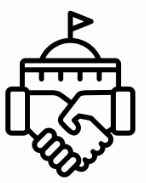
Public Sector (Government, Non-Profit Organizations)
Characteristics: Emphasis on information delivery, user experience optimization, and service guidance
Suggested Tool Combination:
- Adobe Target: Enables differentiated content presentation for landing pages and service guide pages
- Optimizely: Supports UX experimentation and no-code page optimization
- Insider: Useful for pushing citizen service notifications and important event reminders

Media industry (news, audio-visual, streaming platforms)
Characteristics: Frequent content updates, high user return rate dependency, and the need to improve retention and content recommendation accuracy
Suggested Tool Combination:
- Adobe Target: Supports modular content recommendations and layout testing to boost homepage and article page click-through rates
- Insider: Ideal for real-time news alerts, segmented notifications, and instant engagement
- Bloomreach: Its recommendation engine and search capabilities are well-suited for managing large volumes of content and video resources

Small and medium-sized businesses
Characteristics: Limited resources, with a focus on quick deployment and ease of use
Suggested Tool Combination:
- Insider: Simple interface with support for multi-channel marketing engagement
- Dynamic Yield: Flexible recommendation logic and intuitive user experience
- Emarsys: Ideal for entry-level automation needs centered around EDM campaigns

Large corporations or multinational brands
Characteristics: Multiple systems, complex workflows, large data volumes, requiring high integration and international support
Suggested Tool Combination:
- Adobe Target + Journey Optimizer: Integrated with Adobe Experience Platform to build a complete personalization engine
- Salesforce Marketing Cloud Personalization: Strong CRM integration for managing complex customer relationships
- Bloomreach or Optimizely: Enhances content/recommendation integration and supports multi-language website structures
7. Implementation Advice: Start Small, Scale Gradually
Selecting a personalization marketing tool is only the first step — the real challenge lies in successfully implementing it and delivering measurable results. Based on our hands-on experience and success stories from multiple enterprises, here are several practical implementation recommendations to help you turn personalization from a buzzword into a concrete, actionable plan that delivers impact — one step at a time.
Start with a single application scenario and quickly validate the benefits
We recommend starting with a simple, clear, and easily trackable use case, such as:
- Homepage product recommendation module
- Email content that dynamically changes based on audience segments
- Cart abandonment push notifications / reminder emails
- Personalized guidance messages during the registration process
Establish a cross-departmental introduction team and clarify the division of roles
Personalized marketing often involves multiple departments such as marketing, IT, data, and product, which can lead to bottlenecks during implementation due to unclear responsibilities or poor coordination. We recommend forming a dedicated project team with the following key roles:
- Marketing Lead: Defines objectives, designs use cases, and plans content
- IT/Technical Staff: Handles data integration, event tracking, and tag management
- Data Analyst: Designs segmentation logic, tracks performance, and analyzes results
- External Consultant: Provides tool implementation support, technical assistance, and strategic guidance
Four phases of the import process are recommended
- Requirement Clarification and Tool Selection – Clearly define the implementation goals, use cases, initial scope, and success metrics (KPIs)
- Environment Setup and System Integration – Configure event tracking, segmentation logic, and data integration via APIs/CRM
- Scenario Development and Content Design – Build recommendation modules, customer journeys, and push triggers, and prepare creative assets and messaging
- Launch and Performance Optimization – Review results weekly, adjust segmentation criteria and trigger logic, and gradually expand use cases
You don't have to be "complete" at the beginning, but you need to do it "accurately"
Many enterprises tend to set too many goals during the early stages of implementation, which can lead to difficulties in execution. Instead of aiming for full-channel integration and AI-driven personalization all at once, consider the following approach:
- Select a single customer journey first (e.g., member registration → shopping → feedback)
- Define 1–2 personalization touchpoints for each stage
- After completion, gradually expand to other scenarios (e.g., customer service, automated push notifications, sales support)
Regular reviews and internal experience sharing
Continuous optimization and learning after implementation are equally important. We recommend establishing the following mechanisms:
- Review performance reports monthly or quarterly (e.g., CTR, CVR, open rates, return visit rates)
- Facilitate knowledge sharing and data insights between internal marketing teams and external consultants
- Adjust segmentation strategies, journey logic, and content variations based on performance outcomes
8. Conclusion: Choose the Right Tools to Make Personalization Marketing a Reality
In 2025, competition in the digital marketing field will increasingly focus on personalized experiences. Personalization is no longer an option but a critical capability for businesses aiming to continuously attract customers, build relationships, and increase revenue.
Through this article, we explored the definition and value of personalized marketing, introduced common application scenarios, and based on analysis from third-party rating agencies, compiled eight reliable personalization tools. Whether you are from e-commerce, finance, education, media, manufacturing, or B2B sectors, you can find suitable solutions based on your scale and needs.
However, it’s important to emphasize that tools are merely means to achieve goals; what truly impacts results is strategy and execution. The starting point for implementing personalization need not be complex — it can begin with homepage content recommendations, segmented EDMs, and simple push notifications, then gradually expand to more comprehensive customer journeys and AI-driven decisions.
In our next article, we will delve deeper into:
- How to choose among multiple tools?
- What technical integrations and data preparations need to be planned in advance?
- How should resources and objectives be allocated and set during the initial implementation phase?
If you have started considering implementation directions or want to evaluate whether your existing infrastructure can support personalization, we recommend continuing to read our next article:
Additionally, if you wish to receive more specific advice and technical evaluations, feel free to contact us at Leads Technologies. With extensive practical experience, we can assist you in planning the most suitable personalized marketing framework from strategy to implementation.
👉 Contact Us for a Free Initial Consultation
9. References
- 2025 Gartner® Magic Quadrant™ for Personalization Engines
https://business.adobe.com/resources/reports/gartner-mq-personalization-engines-2025.html - Forrester Wave™: Digital Experience Platforms, Q3 2021
https://www.forrester.com/report/the-forrester-wave-digital-experience-platforms-q3-2021/RES161679
https://business.adobe.com/content/dam/dx/uk/en/resources/reports/forrester-wave-dxp-2021/The%20Forrester%20Wave_DXP_2021_EN.pdf - Adobe Target Official Website
https://business.adobe.com/products/target/adobe-target.html - Adobe Journey Optimizer Official Website
https://business.adobe.com/products/journey-optimizer/adobe-journey-optimizer.html - Salesforce Marketing Cloud Personalization (formerly Interaction Studio)
https://www.salesforce.com/products/marketing-cloud/personalization/ - Dynamic Yield Official Website
https://www.dynamicyield.com/ - Insider Official Website
https://useinsider.com/ - Bloomreach Official Website
https://www.bloomreach.com/ - Emarsys (SAP) Official Website
https://emarsys.com/ - Optimizely Official Website
https://www.optimizely.com/
